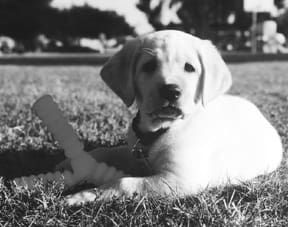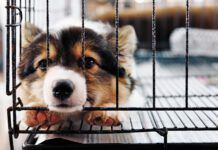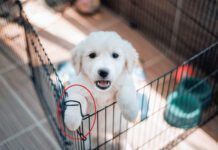Most people spend months preparing for the arrival of a new baby. They’re just as likely, however, to bring a baby dog home on a whim, without any preparation at all. Small wonder they find themselves playing catch-up for weeks, months, years, or even “getting rid of” the dog as they struggle to recover from the mistakes made in the pup’s formative months.
For example, a lack of a crate, puppy pen, or baby gates from day one makes housetraining “mistakes” inevitable. This can set back later housetraining efforts by weeks or even months, as the puppy is triggered to eliminate in spots where he smells remnants of his past “accidents.”
The wise puppy-owner-to-be puts much thought into pre-puppy preparation. When I was a preteen, my parents had the foresight one Christmas to put a gift certificate and a dog bowl and leash in a wrapped package under the tree rather than rushing out to buy the Collie puppy I’d been asking for as a living holiday gift. That gave us plenty of time to prepare for the new canine baby as a family, and to give our new dog a carefully structured introduction to our home.
Pre-puppy preparations fall into three categories:
• Supplies and equipment
• Service providers
• House rules and routines
Puppy Supplies and Equipment
There’s lots of puppy stuff you’ll need to make your puppy comfortable, happy, and successful as he learns to adapt to your alien environment. The following is an abbreviated list from “Tools That Make Dog Training a Breeze,” WDJ February 2002.
1. Crate. A crate is an indispensable behavior management tool; it facilitates housetraining and prevents puppy misbehavior by keeping your dog safely confined when you’re not there to supervise. It allows you to sleep peacefully at night and enjoy dinner and a movie without worrying about what the pup is destroying. See “Crate Training Made Easy,” WDJ August 2000.
2. Puppy pen/exercise pen. This is another extremely useful management tool, but it expands the “den” concept of a crate to a slightly larger area, giving a pup more room to stretch her legs, yet still keeping her in a safe, confined area. Many people include a “restroom” facility, by using a tarp underneath the pen and newspapers on top of that at one end.
3. Tether. This is a short (about four feet in length) plastic-coated cable with sturdy snaps at both ends. Tethers are intended to temporarily restrain a dog for relatively short periods of time in your presence, as an aid in a puppy supervision and house- training program, and as a time-out to settle unruly behavior. They should not be used as punishment, or to restrain a dog for long periods in your absence. See “Tethered to Success,” April 2001.
4. Collar, ID tag, leash, and harness.
5. Seat belt. Use a car restraint that fastens to your car’s seat belts and your dog’s harness (never a collar) to keep her safe, and safely away from the driver. See “Dogs Riding Safely and Calmly in Cars,” February 2004.
6. Clicker. Properly used as a reward marker, a clicker significantly enhances your communication with your furry friend and speeds up the training process. See “The Cop and the Clicker,” March 2001.
7. Treats. A clicker, of course, is nothing without an accompanying reward. We use treats as the primary reward to pair with the clicker because most dogs can be motivated by food, and because they can quickly eat a small tidbit and get back to the training fun.
8. Long line. A lightweight, strong, extra-long leash (10 to 50 feet), the long line is an ideal tool to help your dog learn to come reliably when called regardless of where we are or what other exciting things are happening. WDJ reviewed long lines in “Long Distance Information,” February 2001.
9. Kong toys. If we could buy only one toy for our dog, it would be a Kong, a chew-resistant (not chew-proof) rubber, beehive-shaped toy with a hollow center. A Kong can be used “plain” as a toy, but makes an irresistible treat for any dog when stuffed with kibble or treats that are held in place with something healthy and edible like peanut butter, cream cheese, or yogurt. See “The Many Uses of the Kong,” October 2000.
10. Balls, interactive toys, fetch toys.
11. Grooming tools. Choose combs and brushes appropriate for your dog’s type of coat (ask a groomer or vet), shampoo and conditioner, scissors, nail clippers, cotton balls, and toothbrushes. Start using these tools on your puppy early, pairing the experience with tasty treats so she forms a positive association with the task.
12. House cleaning tools. See “Housetraining Puppies,” January 1999; “Best Dog Grooming Tools for Shedding,” April 2004, and “Biodegradable Poop Bags,” June 2005.
Puppy Care Service Providers
It’s never too soon to start researching the corps of professionals who will help you raise your puppy right. That list will include her veterinarian (or veterinarians, including an emergency hospital, holistic vet, and “regular” vet), training instructor, and perhaps a groomer, pet sitter/walker, doggie daycare provider, and boarding kennel. Grab your phone book, make a separate list for each category, and check them out.
Start with a telephone call. If the provider can’t be bothered to be pleasant on the phone, chances are they won’t be nice in person either. Cross them off.
If they pass the phone attitude test, inquire whether you can visit, ask a few questions, and watch them at work. Then visit. Do they handle canine and human clients gently, and with respect? Are the dogs enjoying themselves, or do they at least appear comfortable? Are the facilities clean, without offensive odor? If the answers to these questions are yes, they stay on the list. If not, cross them off. Make notes next to each of the finalists on your list to remind you whom you liked best and why.
Finally, ask for references. Call the references and ask if they’ve been satisfied with the provider, if they seem reliable and consistently dog-friendly. Then pick your favorite animal care professionals, and let them know you’d like to become a client when your pup arrives. After you’ve made your final decisions, make a list of names, addresses and phone numbers to post on your refrigerator along with the phone numbers and locations of your local animal shelters – in case your precious pup should ever get lost.
Editor’s note: We can’t stress enough the importance of finding a good holistic veterinarian as soon as possible. These practitioners tend to have a more conservative approach to vaccinations than conventional veterinarians – important if you want to prevent the mid- to late-life health problems that some experts believe are related to a lifetime of overvaccination (see “Understanding Canine Vaccinations,” June 2005).
You’ll also want a reliable holistic practitioner in your corner if your dog is diagnosed with a serious condition. We receive innumerable calls from people who are frantically seeking an immediate referral to a holistic veterinarian to treat their dog for cancer and other diseases that took a long time to develop. The problem is, it’s not easy to find someone who practices the type of medicine you feel most comfortable with, and certainly almost impossible in an emergency situation.
New Puppy House Rules and Routines
Rules and routines are especially important if there’s more than one human in the house, to encourage consistency, an important element of successful puppy-raising. When your pup joins your family, she’ll experiment with different behaviors to try to figure out how the world works, and how to make good stuff happen – a dog’s main mission in life. The more consistent everyone is, the quicker she’ll figure it all out.
Your rules and routines will reflect your dog-raising and -training philosophies. To develop a relationship with your dog based on mutual trust, respect, and cooperation, implement nonviolent management and training techniques, and avoid methods that require harsh verbal correction and physical punishment. The better you are at keeping your pup out of trouble and reinforcing desirable behaviors, the less you’ll be upset with her and the sooner she’ll develop good habits. (See “Improving the Dog/Human Relationship,” August 2002.)
Here are some issues for your family to discuss and agree on:
• Where will your puppy sleep? We suggest in a crate in someone’s bedroom until the pup’s at least a year old and fully housetrained and house trustworthy; then her own bed or someone’s bed (or wherever else she wants) is okay.
• Will she be allowed on the furniture? We’re okay with dogs on the furniture within reason – not the kitchen table, of course – as long as it’s not creating any aggression or other behavior problems. We like our dogs to ask permission first if we’re on the sofa and they want to join us.
• Where will she be during the day? The best answer is with you, if you have the luxury of working at home or taking her to the office with you, under direct supervision or leashed and crated, with potty breaks every hour on the hour, at first. If you’re not home, she should be indoors, crated – if you can arrange for adequate potty breaks – or in an exercise pen.
• What games will she be allowed to play? There are games, and then there are games! Good games like “Tug” and “Fetch” reinforce desirable behaviors. Inappropriate games like “Body-Slam the Human” and “Jump Up and Bite Skin and Clothing” reinforce undesirable behaviors. Be sure everyone in the family is on board with teaching appropriate games, and playing by the rules.
If family members insist on an inappropriate game like “Jump Up” (biting is never to be encouraged), get them to agree to teach polite behavior first, then teach “Jump Up” on a very specific cue – and allow it only on cue.
• Who will feed her; when, and what? Your pup should be able to depend on regular and high-quality meals from a clean bowl in a quiet place. If you choose to make it a child’s responsibility, you must supervise to be sure the dog is fed properly. Don’t allow anyone to pester her while eating. Rather, have family members walk by and drop extra-special treats in her bowl while she eats, to help prevent resource guarding.
• Who will train her, how, and for what? We urge you to train using positive reinforcement methods, starting with housetraining all the way through the most advanced training you choose to pursue. You can have a “primary” trainer, and then encourage the whole family to participate in training activities; they’ll all be living with the pup, and they can all learn to communicate consistently and effectively in a language she understands (see “Get Your Children Involved in Training the Family Dog,” January 2002).
Make a vocabulary list of terms your dog learns and post it on the refrigerator, so everyone uses the same behavior cues. Add to the list as she learns new behaviors. Remember that your dog is never too young (or old) to learn. Check out basic and advanced good manners training, agility, rally obedience, tricks, flyball, scent detection, musical freestyle . . . the possibilities are endless.
• How will you correct her for making mistakes? Positive does not mean permissive. If your pup is well supervised she shouldn’t have the opportunity to make many mistakes, but they will happen. When they do, calmly interrupt the pup’s behavior with a cheerful “Oops!” and redirect her to something more appropriate. Make a mental note to ramp up your management or training to prevent the situation from happening again.
Puppies develop lifelong habits during the first several months of their lives. Extra management effort early on can save you years of headaches later. If you don’t give your pup the opportunity to learn that chewing sofa cushions is fun and feels good on sore gums, she’ll earn house freedom much sooner than a confirmed cushion shredder. When you see her heading for cushions or the coffee table leg, offer her a stuffed Kong instead, or engage her in a game of tug.
If she’s driving you crazy, grabbing your pants legs, and biting your hands, say “Oops! Time out!” and put her in her exercise pen for a bit. This will give you both a chance to calm down without resorting to corporal punishment. When she realizes that biting makes the fun stop, she’ll learn to control her urge to grab.
Sound like a lot to think about? It should! Accepting responsibility for the life of another living creature requires serious thought and commitment. The way you care for your pup will determine whether she spends the rest of her life sharing companionship and love with you or, like too many dogs, gets passed from home to home in search of one where she will be better understood and appreciated. She deserves a lifelong loving home. They all do.
Pat Miller, CPDT, is WDJ’s Training Editor. She is also author of The Power of Positive Dog Training, and Positive Perspectives: Love Your Dog, Train Your Dog. Miller lives in Hagerstown, Maryland, site of her Peaceable Paws training center.







I like that you suggested that when feeding the puppy we should give her treats so that she won’t be aggressive and feel she has to protect her food. I’m going to give my son a puppy for Christmas and we are starting to prepare for her arrival. These tips will really help us get a mindset for when the puppy arrives in our home.
Hello,
This is Great. You’re right, a lot of Equipment needed to make a puppy comfortable, and happy. In particular, these equipment are much-needed for puppy #Puppy exercise pen, #Seat belt #Kong toys, #Clicker. Thank you for sharing a nice article.
Priyota Parma
Executive Consultant
Dog Mexico
I like your suggestion to post a list of vocabulary terms on the fridge to make sure everyone in our family is using the same commands for consistency. I like the idea of buying a poodle puppy that already has some training to help things go more smoothly as the dog adjusts to their new home. Since the dog should already be familiar with a few words, the tips you shared here will be really helpful as we start teaching her more!
I like that you proposed that when taking care of the doggy we should give her treats so she won’t be forceful and feel she needs to secure her food. I will give my child a doggy for Christmas and we are beginning to get ready for her appearance. These tips will truly assist us with getting an outlook for when the little dog shows up in our home.
I like your post. A lot of Equipment needed to make a puppy comfortable, the tips you shared here will be really helpful as we start teaching a puppy more. Thanks